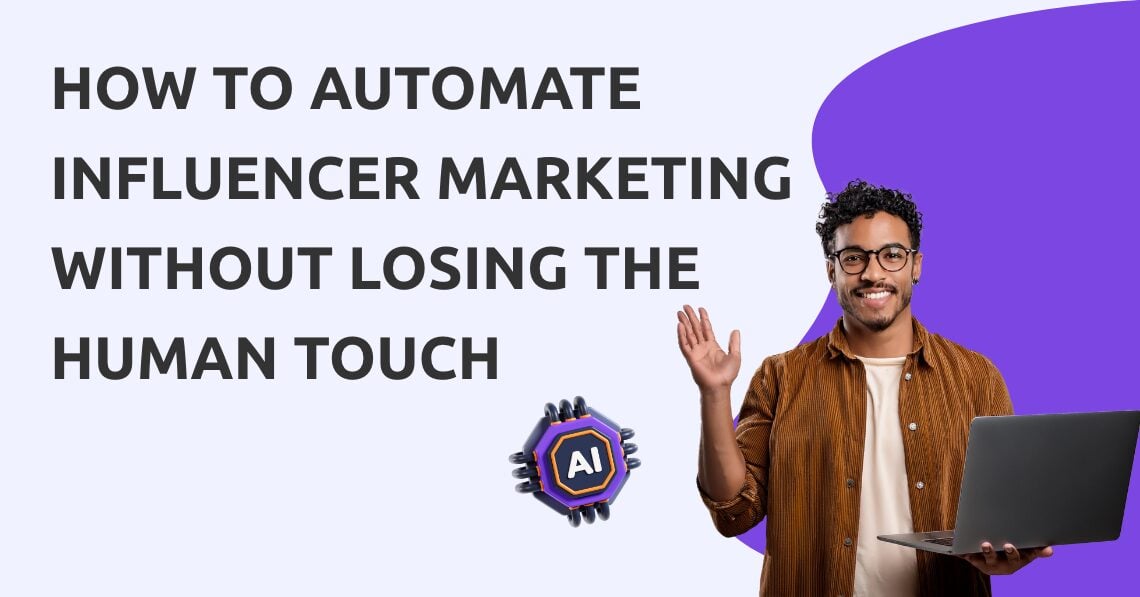Ever found yourself staring at your analytics dashboard, wondering where your customers actually come from? As a marketer, you may spend weeks optimizing your website and creating blogs.
Then, you get a ton of traffic. Now, you want to replicate that success, but it's tricky to find the content, platform, or strategy that did the job, especially with non-linear customer journeys being the norm now.
Well, you're not alone. The availability of numerous touchpoints across platforms coupled with the reliance on AI-driven search engines (which have seen a 525% surge in revenue) rather than traditional organic search results has made it a tad complicated to follow customer journeys with the standard SEO playbook. We've put together this guide to help you navigate this new normal with ease.
- Optimizing Technical Health for a Seamless Customer Journey
- SEO Tactics to Drive Engagement at Every Stage of the Journey
- Strategies for Navigating Non-Linear Customer Journeys
- Overcoming SEO Customer Journey Mapping Challenges
- Navigating the Modern Customer Journey with SEO Success
- Frequently Asked Questions
Optimizing Technical Health for a Seamless Customer Journey
A slow, clunky, or confusing website with poor technical SEO is bound to frustrate potential customers, regardless of the quality of your product or service. Similarly, if your website isn't optimized for the device the customers are using, they're likely to bounce off and find a competitor's website instead.
So, your website needs to look and feel as good as your products or services actually are. But how do you get there?
You need to ensure your website is technically healthy and optimized for audiences (yes, audience first, search engines second). And with 95% of internet users accessing the web with their mobile phones, a responsive, fast-loading mobile experience isn't just optional but a necessity.
On top of that, your website should be easy to navigate. Think of it like a physical store. Everything should be organized, labeled clearly, and easy to find. This way, customers will have an easy time getting what they want and are more likely to stay on your website longer.

Source: zara.com
However, aesthetics and user interface alone don't cut it. You also need to establish trust signals, such as trust badges, accreditations, customer reviews, and ratings, to build credibility with your audience. Plus, HTTPS is a must for securing your customers' personal information and protecting them from cyber threats. If your website has any kind of online transaction, it's imperative to have an SSL certificate. Also, your privacy policy should be transparent and easily accessible.
While all that was for the visitors, search engines also demand a certain level of website optimization. First, your site's pages must be crawlable and indexable. Simply put, search engines can easily access, read, and store your content in their databases to rank them for relevant keywords.
Second, the structure of your website matters a lot. An organized hierarchy of content helps search engines understand the relevance and relationships between different pages. Moreover, schema markup can help mark up your content in a way that search engines can better understand.
SEO Tactics to Drive Engagement at Every Stage of the Journey
A full-funnel marketing strategy requires a customized approach at every stage of the buyer journey. The four stages that the majority of buyers go through are awareness, consideration, decision, and post-purchase retention or loyalty. Your key task is to engage your customers at each of these stages.
Keep in mind that customers may not always move in a linear direction. They may switch between different stages or even go back to a previous stage. So, keep your strategy flexible and adaptable.
We'll use the example of someone buying a lamp for their work desk to illuminate (see what we did there?) different engagement tactics at each stage. Plus, we’ll also recommend tools for different SEO tasks required during the buyer journey.
Since each stage of the customer journey has different demands, it can be a bit overwhelming to consult multiple tools (and pay for them individually) to address these needs. Luckily, Semrush is quite comprehensive and has tools to cater to your content and SEO strategy at every stage.
Explore Your Options
In the first stage, the prospect is simply exploring and learning. They may or may not know your brand already, so your goal is to get noticed without being pushy. Let's say they are using queries like "How to improve workspace lighting" to see what their options are.
You need to:
- Target high-traffic keywords that reflect what your audience is searching for
- Create content that meets informational intent, such as how-to guides, educational videos, or blog posts
- Use collaborations or guest blogging to make your content visible to a wide audience
Example:
Collaborate with a popular interior design blogger to create a post on "7 Ways to Brighten Up Your Workspace" and casually mention your lamp as one of the recommended items.
Awareness Stage
As we've explained, this is the stage where you have to get your long-tail keyword strategy right. The Keyword Magic Tool helps you in this regard. Taking the same example forward, you can search for the seed keyword ''lighting options.'' The Keyword Magic Tool will then show you a host of keywords related to the topic that you can further filter based on search volume, intent, keyword difficulty, and other factors.

Keyword Magic Tool
To start, filter the results by informational intent since that is the content you need to write at this stage. Semrush also has advanced filters that let you find keywords with certain terms like ''how to'' and ''guide'' in them. Use the Include Keyword filter to get specific matches.
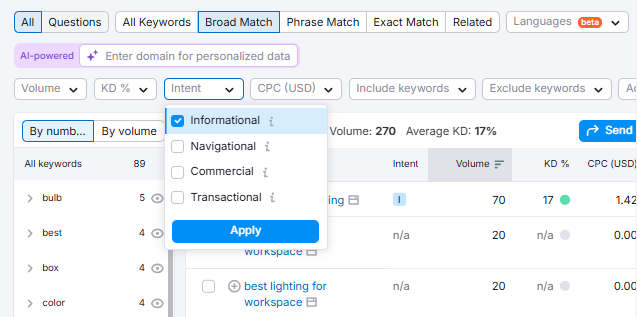
Intent filter in Semrush
That's what the pet company Hepper did. They used the tool to find intent-based keywords that include ''cats'' and ''how to'' or ''why do.'' Based on the keywords provided by the tool, they were able to come up with over 100 article ideas. As a result, they published 5,000 articles and increased their daily organic pageviews to 90,000.
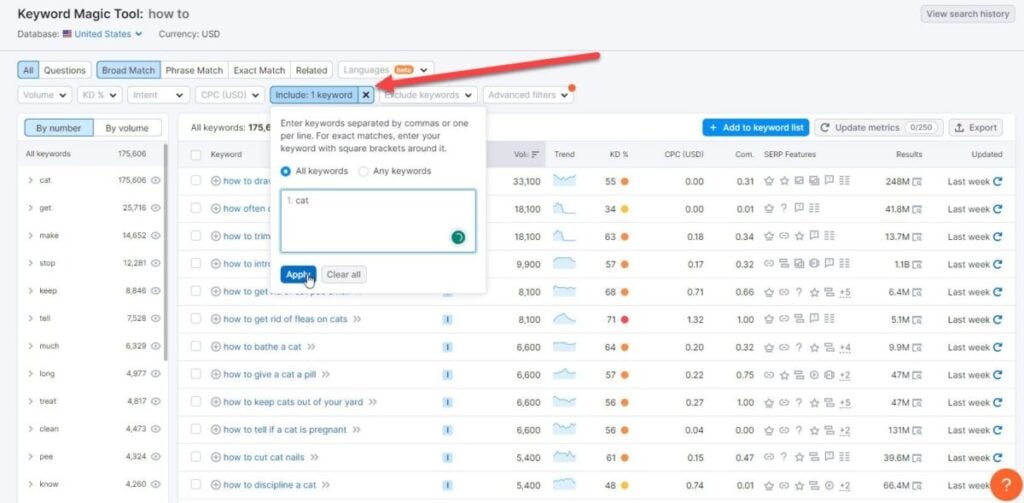
If you think a certain keyword has high potential, you can then generate ideas related to it using the Topic Research tool. It will also show you the keyword search volume and heading ideas for your articles. Plus, the tool provides related questions that people ask. These are the questions that your prospects are using in the early awareness stage, so you should address them in your content.

Evaluating Options
At this stage, the customer has somewhat decided that among all workspace lighting options, a lamp is the best fit for them. Their goal now is to narrow down their choices, so you have to highlight why your offering is the best choice.
For that, you can create in-depth guides, such as "The Ultimate Guide to Choosing the Best Desk Lamp for Your Workspace." Social proof is really helpful at this stage. You can showcase user-generated content (pictures and videos of lamps in their workspaces) on your website and social media platforms or display customer reviews about your lamps.
As for keywords, optimize for terms like "best," "top-rated," or "compare" to capture users actively researching their options. Speaking of "compare," you can create comparison pages that show how your product stacks up against similar ones in the market. Be honest; highlight your strengths and address questions your competitors might not.
Example: You can create a comparison page that shows the unique features of your lamp, such as adjustable brightness and color temperature, compared to other popular desk lamps that lack these features. Going into the consideration stage, you can use the Keyword Magic Tool again to find the middle of the funnel (MOFU) keywords for your product or service. As we’ve mentioned above, "best," "top-rated," or "compare" are the keywords people search for when they have identified their problem and are evaluating different solutions. For example, here are some results for keywords with the word ‘’best’’ in them, which you can target to rank higher during the decision-making phase. Keyword Magic Tool You also need to track the performance of your early and middle-stage content. For that, use the Position Tracking tool in Semrush. Look at the Positive Impact tab to see if these keywords have gained visibility. Semrush Position Tracking Since more and more people are now getting information from the AI Overviews and featured snippets, you should also track keyword appearance here. The SERP features section will provide this information. Semrush SERP features You can further use the Keyword Gap tool to see if you're missing keywords your competitors are targeting. Again, filter them by words or intent to find the best phrases to target in your content. Focus on keywords with a low Keyword Difficulty (KD%) score to prioritize opportunities where you can rank more easily. Keyword Gap tool You can also create topic outlines for these queries using the SEO Content Template tool. The tool uses the top 10 ranking pages for research, so you get insights from which sections and headings your competitors are targeting to enjoy their current visibility in the SERPs. Also, go through the semantically related keyword suggested by the tool to further enhance your content for the middle of the funnel. SEO Content Template Your prospect is ready to act; they just need that final push. Make it as easy as possible for them to choose you. Go for keywords, including terms like "sign up" or "buy." As a local business, "near me" searches are also important to target. Follow the technical SEO tips we've given above to make sure when the prospect lands on your website, they have no trouble or security concerns while going through the transaction. Include testimonials and customer reviews on landing pages to provide social proof. If you're a local business, embed Google reviews on your website. Also, use schema markup to highlight key information like star rating, availability, shipping times, payment options, and pricing so that the prospect can get maximum information directly in search results. Example: You embed customer reviews from Google and third-party sites on your website. Grand Rapids Lighting, a Michigan-based lighting store, has done this. This not only builds trust with potential buyers but also enhances credibility by showcasing real feedback, making it easier for prospects to choose your business over competitors. Source: grandrapidslighting.com After you've created the content to engage prospects, the next step is to optimize the landing pages for conversions. Use the On-Page SEO Checker tool to see where there's room for improvement on your web pages. On-page SEO checker Pay close attention to these categories: user experience ideas, technical SEO ideas, content ideas, and SERP feature ideas. Implement these suggestions to improve the overall on-page SEO for decision-related pages, such as product or service pages. You can also use the Site Audit tool within the On-Page SEO Checker to make sure that no technical problems are keeping your prospects from finding what they need on your website. Here, you should focus on HTTPS, markup, site performance, and crawlability issues. If you get customers from around the world, check the international SEO tab for improvement recommendations, too. Semrush Site Audit Sometimes, the missing link is something as obvious as schema markups. Take a leaf out of Wix's book. The company added the "how to" schema to over 100 of their articles and further optimized them for on-page SEO using Semrush. They also used the Keyword Gap tool to find ideas for how-to articles based on the topics their competitors were covering. This simple approach brought over +7,000 clicks to "how to" URLs. Wix case study They've bought the lamp from you. Excellent! But you also sell other types of lighting and home decor items. So, their relationship with your business isn't over yet. So, you can follow customer loyalty trends to retain the buyer. Customer loyalty trends In the post-purchase stage, focus on content that targets keywords like "how to use (product name)" or "accessories for (product category)." Similarly, "tips for (your product)" or "upgrading (service name)" are retention-focused keywords. Show your customers that you haven't forgotten about them by sending them exclusive tips or inviting them to your community (if you have one). Offer them personalized discounts and promotions based on their previous purchase. More importantly, anticipate common post-purchase questions and make answers easy to find. A strong knowledge base builds trust and reduces support tickets. Example: You send customers birthday discounts via email to build loyalty. In this stage, you're mainly focusing on building customer loyalty and retaining them for future purchases. Use the Traffic Analytics tool to get an estimate of how many repeat visitors you're getting. The tool shows you both total visits and unique visits so you can see how many people are coming back to your site. Ideally, the higher, the better. Source: semrush.com Here, you can also see the traffic channels your visitors are using, such as email, paid social, paid search, organic search, and referral. This will give you an idea of which platforms to focus on for your customer loyalty efforts. Traffic channels by type Similarly, check the Traffic Journey section to see where your audience is going after they make a purchase from you. For example, if their destination is Facebook, you could invest in Facebook retargeting ads to continue engaging with them post-purchase. Traffic Journey As a local business, you can use the Review Management tool to answer customer reviews on popular platforms like Google and Yelp. Besides building loyalty, this also helps you collect ratings and testimonials to show to new customers in the consideration stage. At the same time, use the Brand Monitoring app to track your brand's mentions across keywords and social media posts. Ideally, you should have a positive sentiment in all mentions. If there are negative mentions, identify the reason and address it in your TOFU and MOFU content to maintain your brand's reputation since that's integral to prospects moving through marketing funnels. Source: semrush.com Rajesh Srinivasan, the founder of Mindful Marketing, took a rather lyrical approach to explaining how customer journeys are not linear anymore but quite the opposite. Two couplets from his "poem" that take the point home are: No straight line from ad to store, it seems, But a zigzag drive with countless themes. Curves and bends, unexpected turns, Marketers must adapt as the tide churns. You need to keep this pattern in mind when navigating non-linear customer journeys. Your audience doesn't live in one place; they hop between Google and Instagram, YouTube and TikTok. So, you should integrate SEO with social touchpoints to ensure prospects get sufficient exposure to your brand. You could: As most internet users are accessing both social media and web searches using their phones, you also need to emphasize mobile-first indexing in your strategy. In fact, social media platforms like TikTok are at the forefront of implementing the shift from linear to non-linear customer journeys. After introducing its Shopping Ads, TikTok replaced the debate around linear marketing funnels with its version of the modern buyer journey: The Infinite Loop. According to the platform, they meet customers where they want to be met, making the buyer journey a loop ‘’with no start or end point.’’ Instead of moving from awareness to purchase in a straight line, users on TikTok are caught in an infinite loop of discovery, engagement, and decision-making. A single scroll can introduce a user to a product through an entertaining video, followed by a series of related posts, reviews, or trends amplifying the message. This dynamic cycle allows consumers to move fluidly between phases, sometimes revisiting earlier stages as they discover new content or perspectives. As a result, much of their time is spent in the awareness and consideration stages. Basically, you want to cover what Isabell Fringer, a journey management expert for mid-sized businesses, calls the "messy middle." Prospects are likely to stray during the consideration stage, so you should create flexible strategies to cover multiple touchpoints that can bring them back to your website. A major challenge in customer journey mapping is gauging where SEO fits in. Since non-linear journeys have multiple touchpoints, it's hard to assign credit to a single channel, like SEO, for a conversion. As we've explained in our State of Marketing Report, you should invest in data-driven attribution models like last-click, position-based, or linear to understand how your SEO efforts are impacting conversions. To decipher which content is actually driving conversions, keep an eye on relevant metrics like time on page, bounce rate, engagement, and conversion rate, especially for decision-focused pages. The Semrush Traffic Analytics tool helps you find this information for sign-in, log-in, check-in, and thank-you pages. For example, if you notice that a blog post on your website ‘’Top 5 Tips for X’’ has a high time on page with above-average engagement and is leading to a spike in thank-you page visits, it’s likely influencing purchase decisions. However, we’ve already explained that customer journeys are non-linear, and that’s a notable challenge. So, a customer is not just converting because of the blog post. They may be signing up for your newsletter and going through your social media pages, too. So, you need customer journey analytics software to collect data for each touchpoint and understand how it fits in the overall journey. The Traffic Analytics tool shows you the touchpoint in a customer’s journey, including the sources and destinations. For example, you may see that a customer finds your brand on Google, comes to your website, and then goes to your Instagram page. This means you have to focus on your social media strategy just as much as SEO to convert that customer. By connecting these dots using a customer journey analytics tool, you can turn the aforementioned challenges into data-driven opportunities. From early awareness to post-click experiences, customers take a winding path to conversion. SEO has quite a major role to play at every step of this journey. A holistic content marketing approach, top-notch user experience, loyalty campaigns, and technical optimization have to work in tandem to take a prospect from finding the solution to their pain point to actually buying your product that solves the said problem. You need a comprehensive, feature-rich tool that offers a solution for every task during the process, including keyword research, content optimization, on-page SEO checking, site audit, and more. Semrush is that tool, letting you manage the SEO side of most steps of your customer journey with ease. The Semrush Traffic Analytics tool gives you an overview of customer journeys, including their sources and destinations. It also tells you the device and channel the customers are using to come to your website. You can also use the Google Analytics Behavior Flow report to visualize how users are navigating through your website. Start by setting up Google Analytics to track how users arrive at your site and what pages they visit. You can then use the Semrush Traffic Analytics tool to see customer touchpoints, such as social media or third-party review sites. Technical SEO ensures that your website is crawlable so that search engines can index it. Plus, it keeps your website fast, user-friendly, secure, device-friendly, and easy to navigate. All of these factors guide customers through the decision phase without any technical hurdles. At the awareness stage, focus on broad, informational keywords like "how to," "what is," or general topics related to your industry. For the consideration stage, look for more specific, comparison-focused keywords such as "best (product/service) for (need)" or "(product) vs (product)." You can use the Semrush Keyword Magic Tool to find these keywords. In the decision stage, target high-intent keywords like "buy (product)," "(service) pricing," or "order (product)." These terms signal that the user is ready to make a purchase. Here are some ways to ace this: Some common mistakes in doing SEO for customer journeys are ignoring user intent, not personalizing experiences, overlooking mobile optimization, and working on a linear journey map. You can avoid these issues by creating intent-centric strategies, optimizing websites for all devices, and personalizing experiences for non-linear journeys. Plus, analyze data at every touchpoint to fine-tune your strategy. You can integrate SEO with: Content is the driving force that usually takes customers from one stage of their purchase journey to the next. It informs prospects about your brand and shows them why you are the best solution for their needs. Plus, content provides social proof through case studies and reviews to build trust. In the post-purchase stage, it assists buyers in using your product or service to its full potential through user manuals and tutorials. Consideration Stage

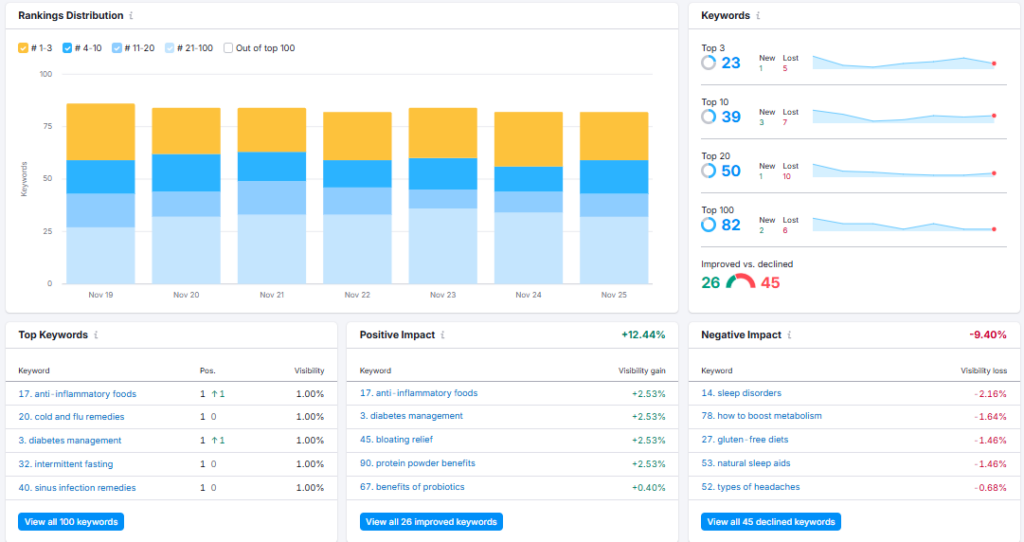

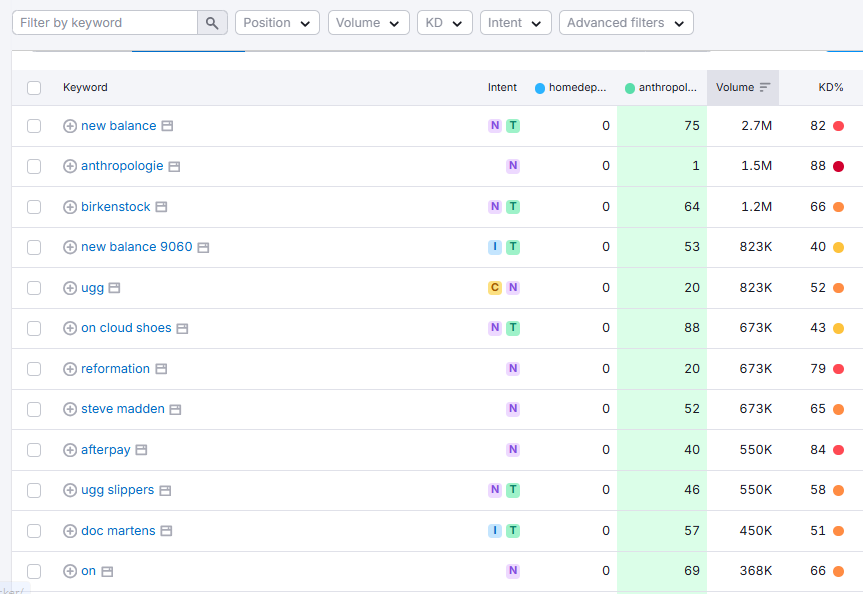
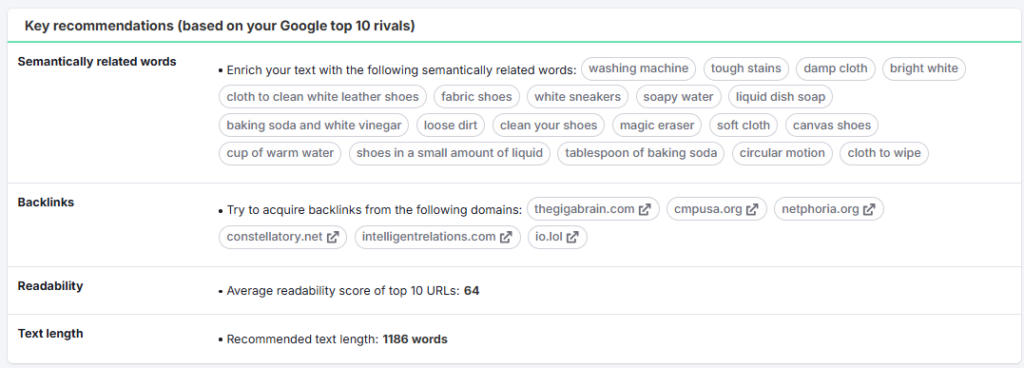
Time to Buy (the Desk Lamp)
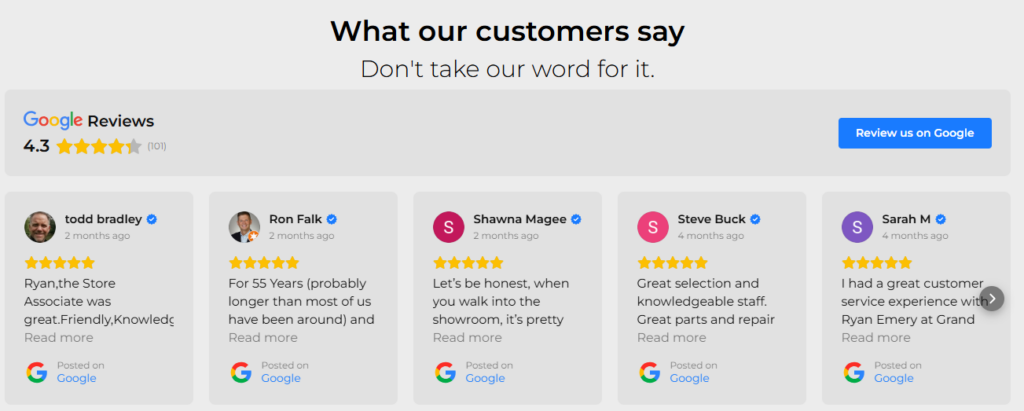
Decision Stage


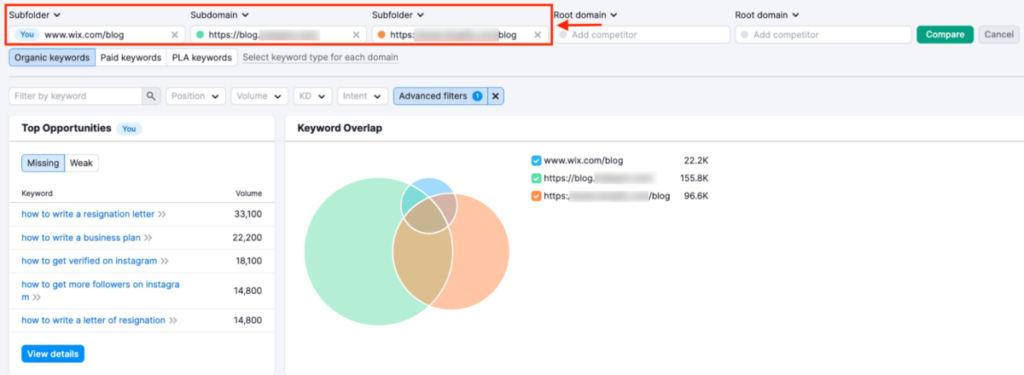
Bringing Customers Back for the Second Purchase
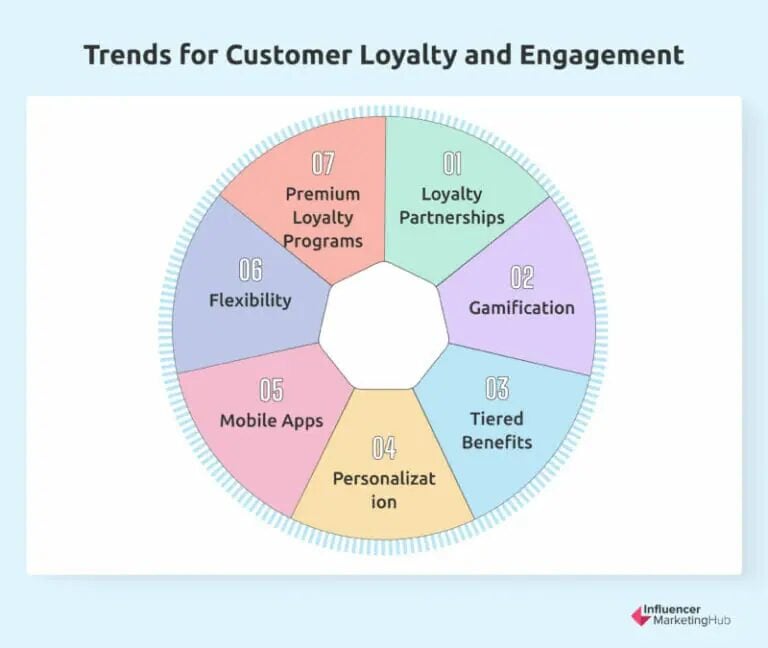
Post-Purchase Stage: Tools to Use
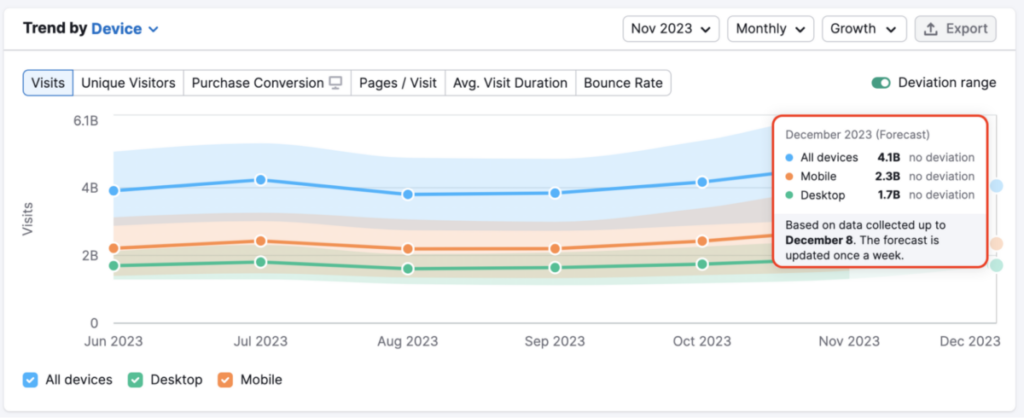
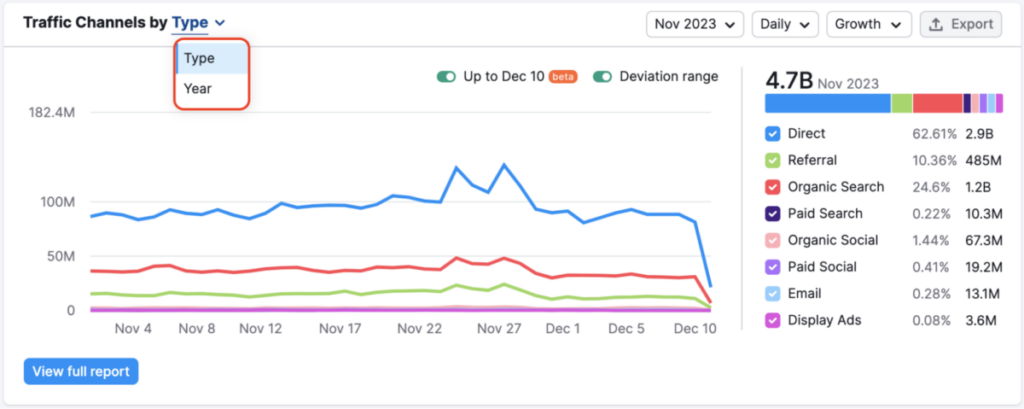
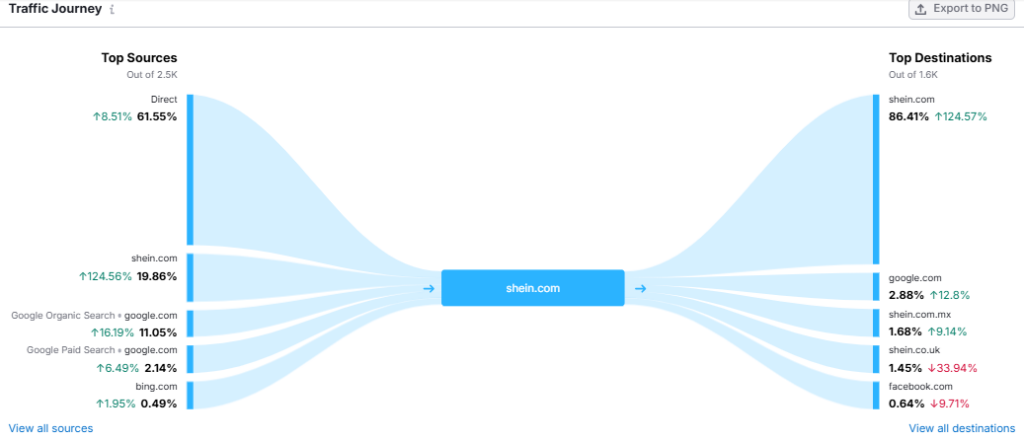
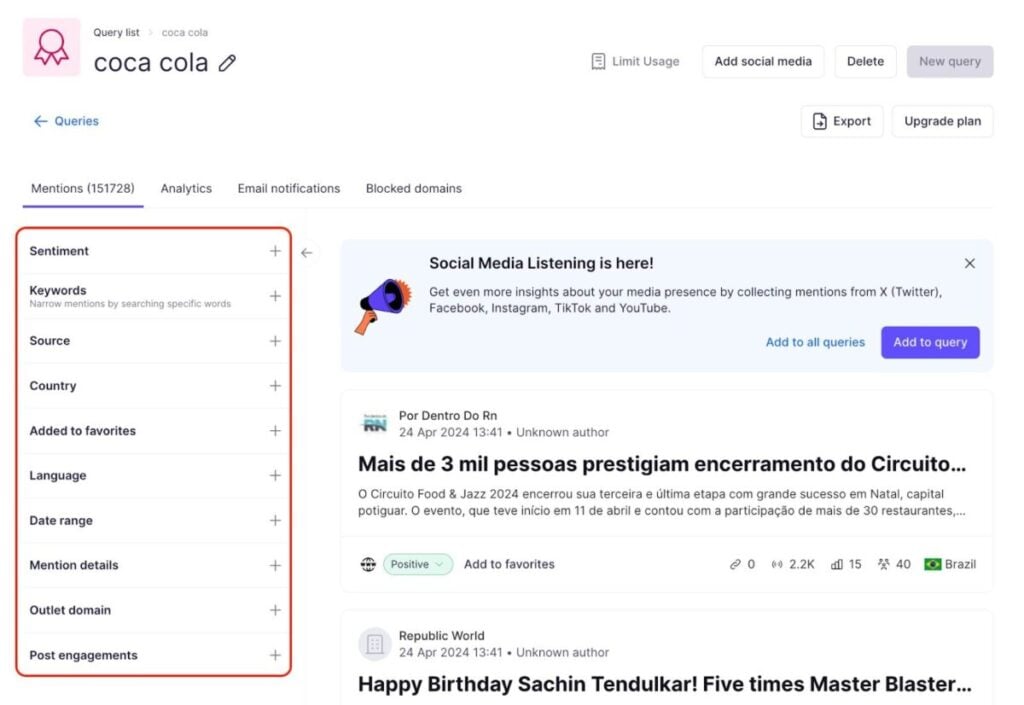
Strategies for Navigating Non-Linear Customer Journeys
Overcoming SEO Customer Journey Mapping Challenges
Navigating the Modern Customer Journey with SEO Success
Frequently Asked Questions
How does SEO support each stage of the customer journey?
What tools can I use to map the customer journey in SEO?
How do I track SEO touchpoints in the customer journey?
What's the role of technical SEO in the customer journey?
How can I find out which keywords are most effective at each stage of the customer journey?
How can I align my SEO strategy with the customer journey?
What are common mistakes when combining SEO and the customer journey?
Can SEO be integrated with other marketing channels in the customer journey?
What role does content play in SEO and the customer journey?
